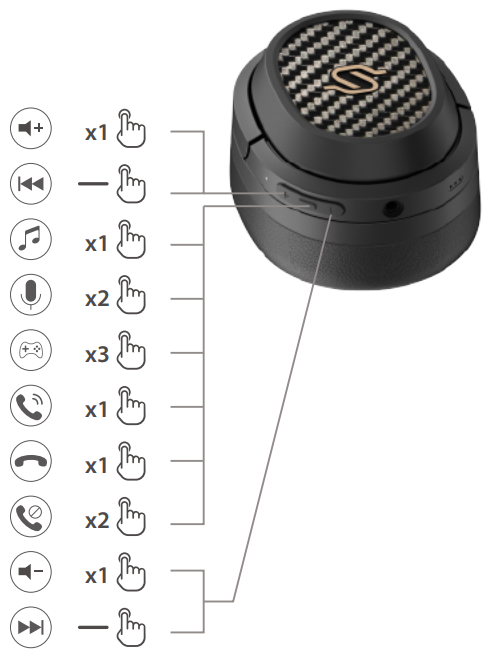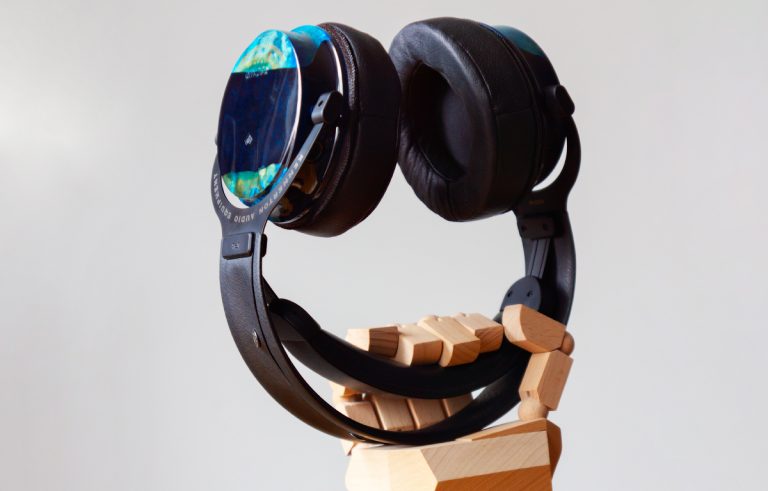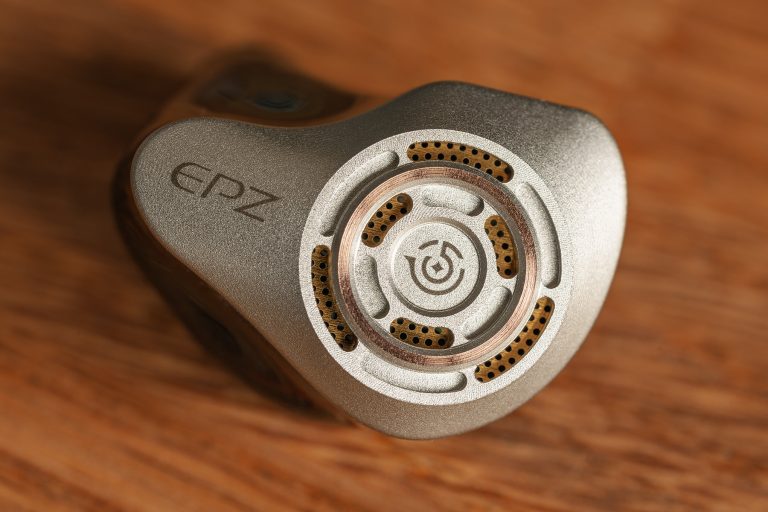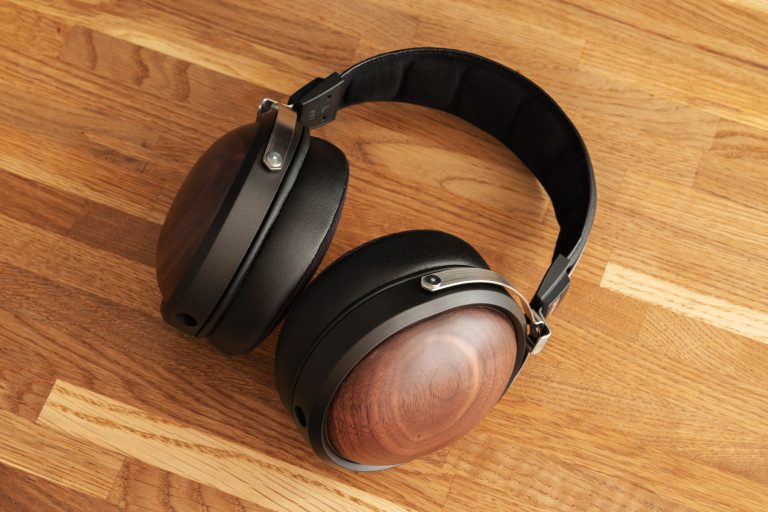Edifier STAX Spirit S3 Review. An 80-hour ear bleeding marathon
Here are the headphones that I, again, was really waiting for. These are the Edifier wireless planar ones powered by Audeze technologies. And the symbolic STAX in the model name kind of suggests THINGS. Well, since closed-back planars with decent sound are something manufacturers don’t always achieve, it was double as interesting for me to take a look at this Edifier masterpiece.
Okay, let’s go. The Edifier STAX spirit S3 (hereinafter – S3) wireless closed-back headphones with isodynamic drivers.
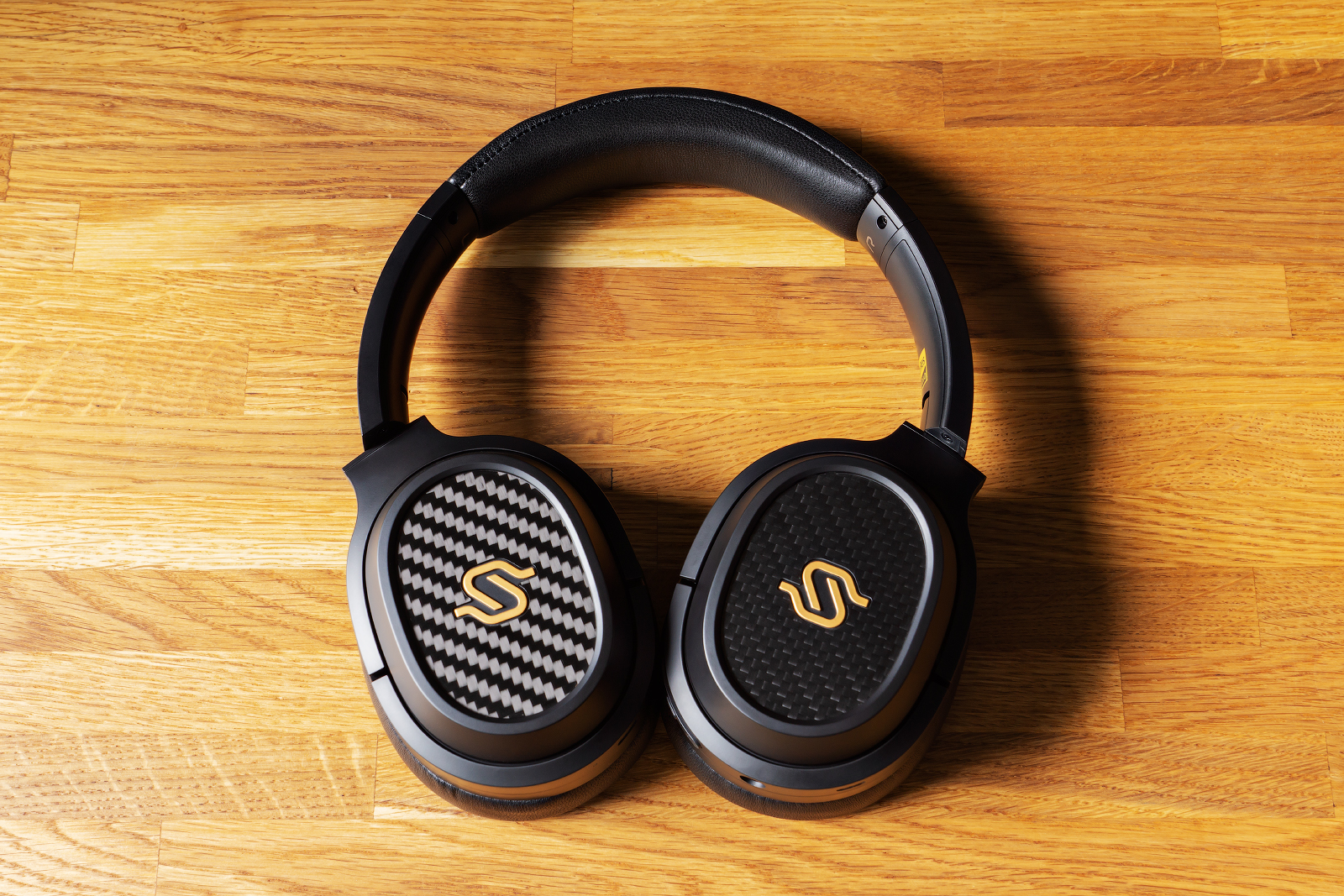
Bought them on sale on Aliexpress for $345, while outside of any discount rush these cost some $443. Nice deal, alright.
What do STAX and Audeze have to do with it
It’s pretty simple.
- In 2012, the Edifier bought the STAX company. I’m going to tell more about the STAX/S3 relation below.
- In 2016, the Edifier invested $4,000,000 in the Audeze (source). The manufacturer’s website said the following: ‘Edifier cooperated with (…) Audeze LLC to implement its global market strategy’. Whatever that means. The Audeze gave the S3 model the planar driver technologies — Fluxor, Uniform, Fazor — as well as its case and a headband design identical to that of the Audeze LCD-1 model.
What’s included
You find your S3 in a large black cardboard box. So premium, much luxury. What do you get:
- the headphones;
- the carrying case;
- an additional set of earpads in separate pouches;
- the USB Type-C cable;
- the 3.5-to-3.5 jack cable;
- the 3.5-to- 6.3 adapter;
- the tool for removing the earpads.
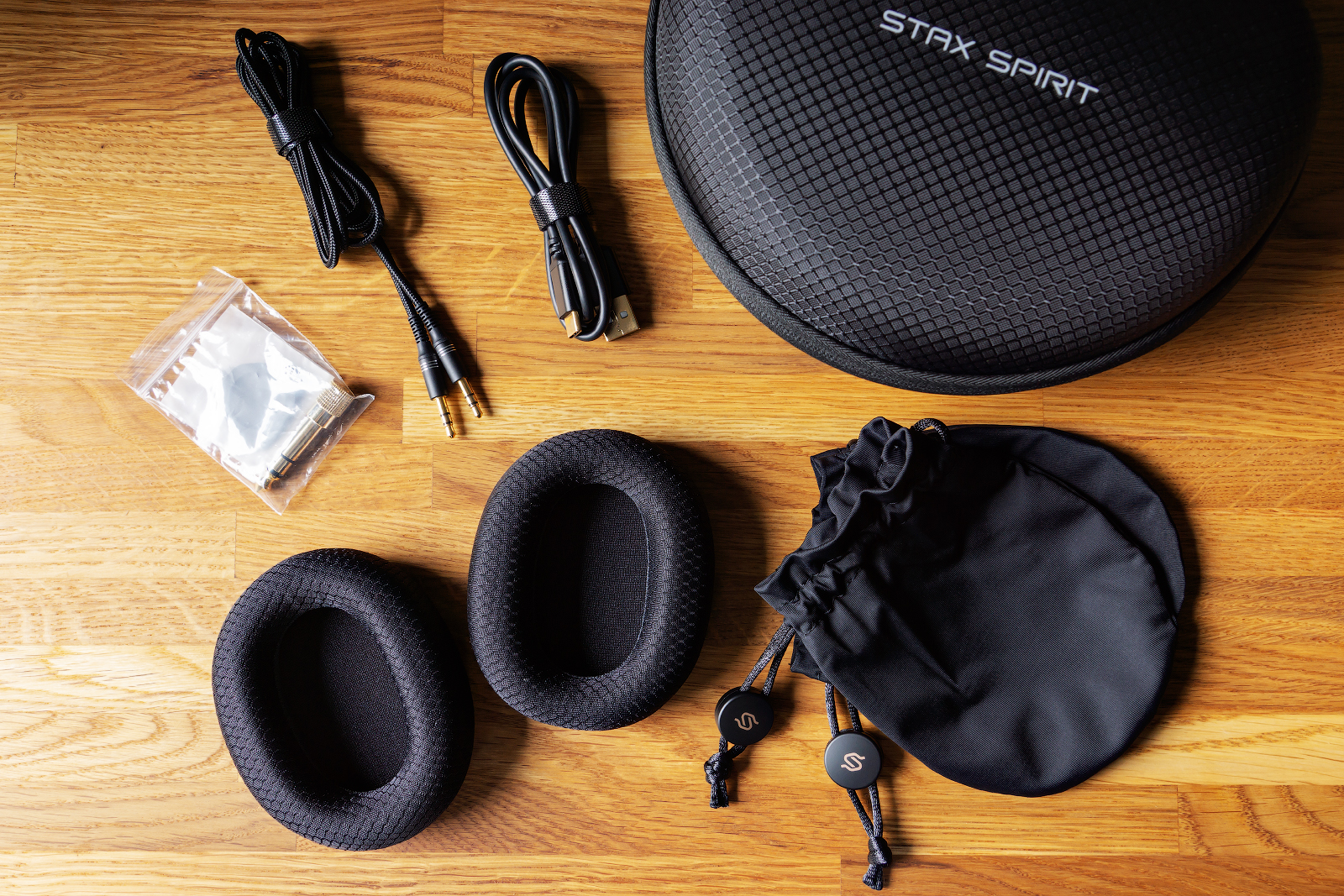
Everything inside the box (and including the box) looks expensively minimalistic. The manufacturer clearly hints that these aren’t just another pair of wireless headphones, but a premium product for the demanding listener. No multicolored inserts nor streaming services discount coupons. Big deal, guys, it’s a freaking premium.
Design, assembly
Being a portable model, the S3 are manufactured and assembled pretty decently: if something’s loose and moving, then it should be loose and moving (since these are folding design headphones we’re talking about). The (seemingly) carbon inserts on the outside of the earcups, as well as a lot of plastic details, draw your attention immediately. The hinges that allow the headband to fold have metal bases.
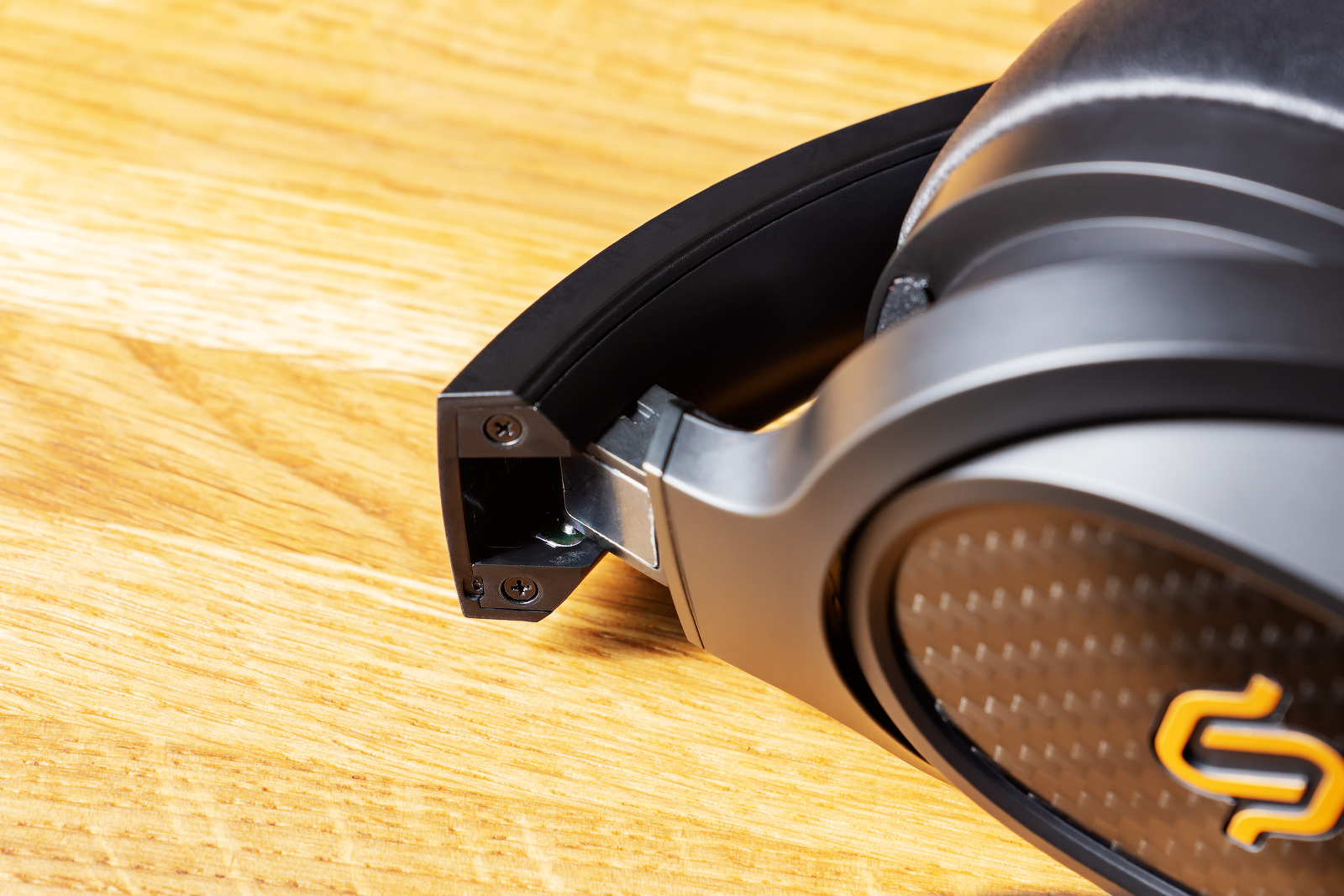
In the upper part of the earcups, there are compensation holes covered with mesh, as well as small shock-absorbing pads.
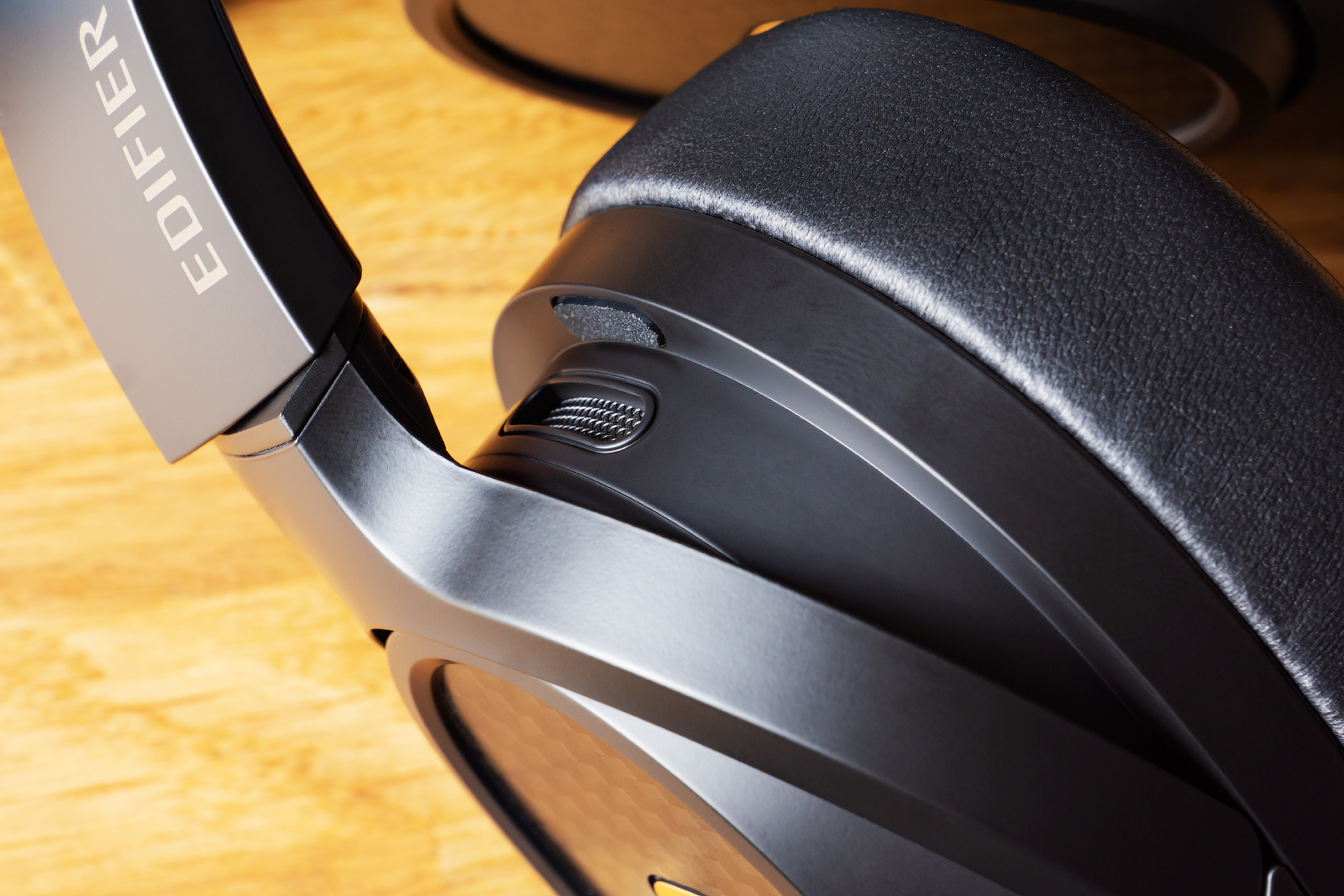
The earcup yokes slide discretely: it’s not easy to feel those positions, though. However! The earcups themselves can be rotated around a vertical axis, allowing a comfortable position on your head.
The earpads are kept at bay thanks to latches: to remove the earpads, you’ll need that special tool (looking like a guitar pick) you can find in that luxury black box of yours. Or you can just use your credit card, because why not. The earpads are made of lambskin, which is also used as a headband lining material. Remove the earpads, and you’ll see an 89 * 70 mm isodynamic driver covered with an acoustically transparent mesh. The membrane size spec is nowhere to be found.
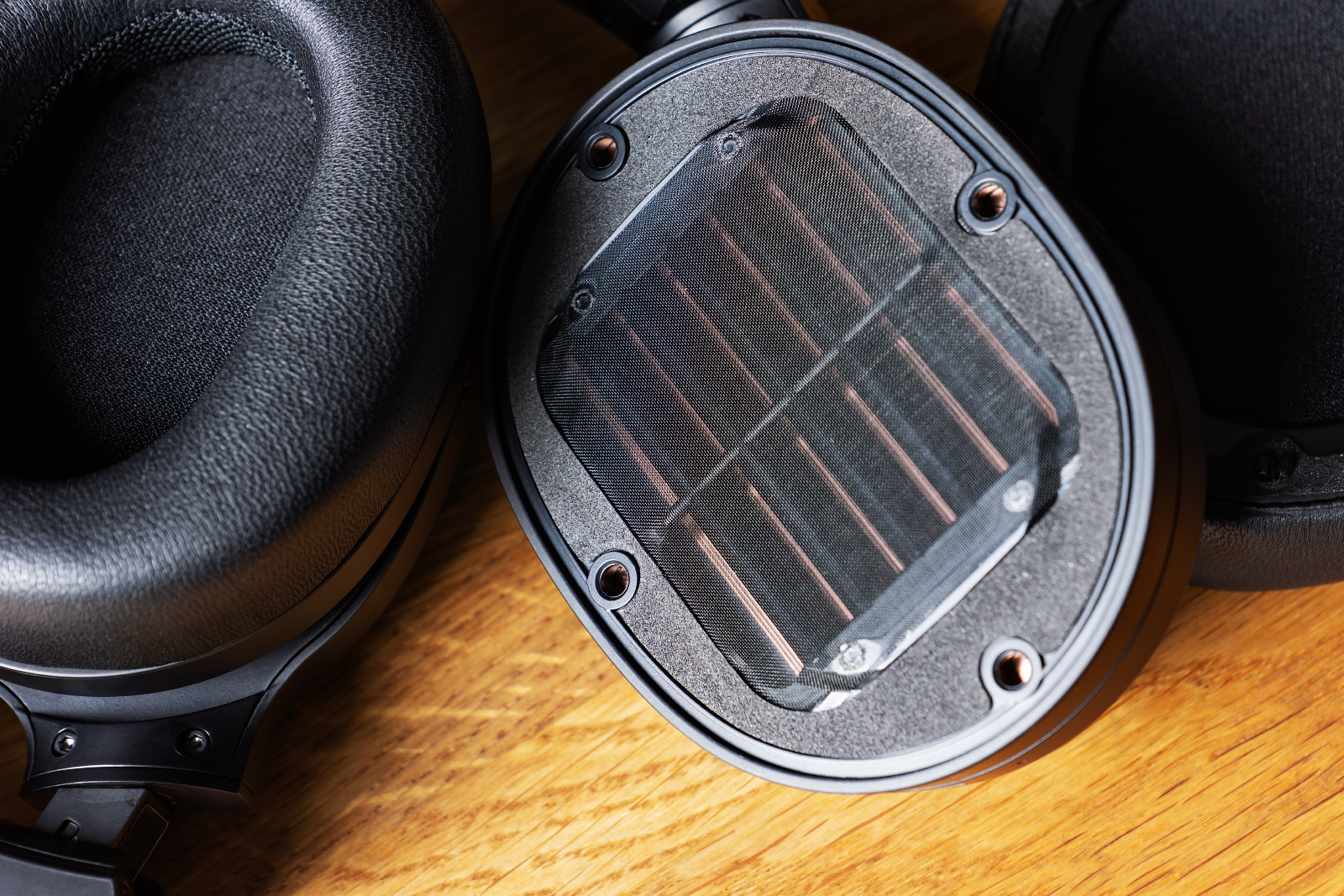
There are control buttons at the bottom of the right earcup. On the left one, there’s only a USB Type-C port.
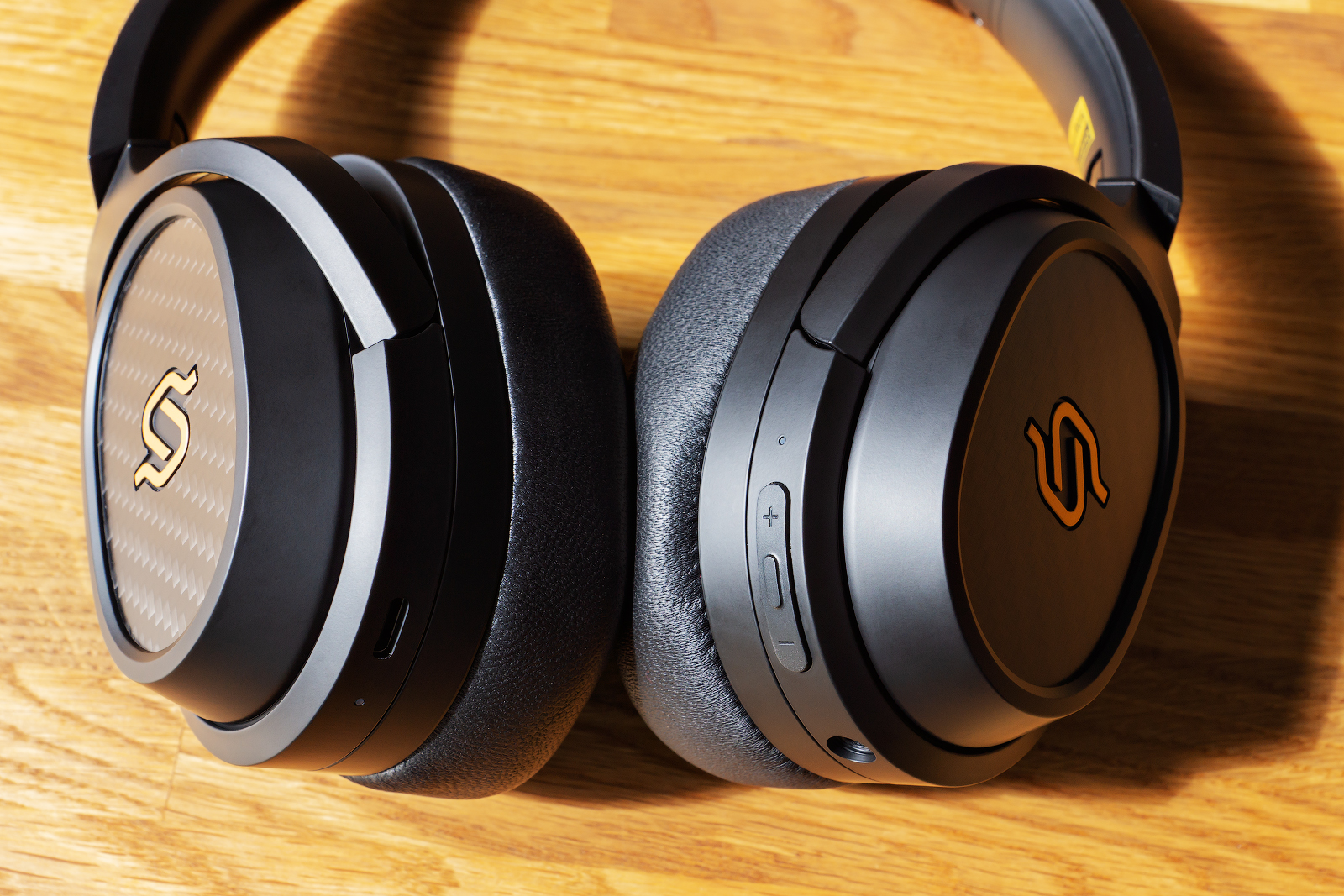
What looks like the only button is actually 3 buttons. The ‘+’ and ‘–’ obviously adjust the sound volume, and the central one does the rest. There’s also an analog input hole. No touch pads: all control is done with that multifunctional central button.
The overall design is really good: it’s engineered, it’s well-built, it’s ergonomic. You’d even think the S3 won’t break at least in the first year of use (if properly handled). Let’s see.
Mobile app
The proprietary Edifier Connect mobile app is frankly poor: the manufacturer either developed it for the sake of the app (‘let’s just do it – everyone else has one!’), or they thought their S3 is a really serious business – audiophile functional purism for all, no bells and whistles allowed. Separately, I’d love to highlight their interface localization work. If the headphones are turned off, the app tells us about it like this:

Which is probably an evasive maneuver – ‘the headphones aren’t off: they’re unconnected’. And if you’d ever want to set up the automatic shutdown, then you’d want to have more than just a need:
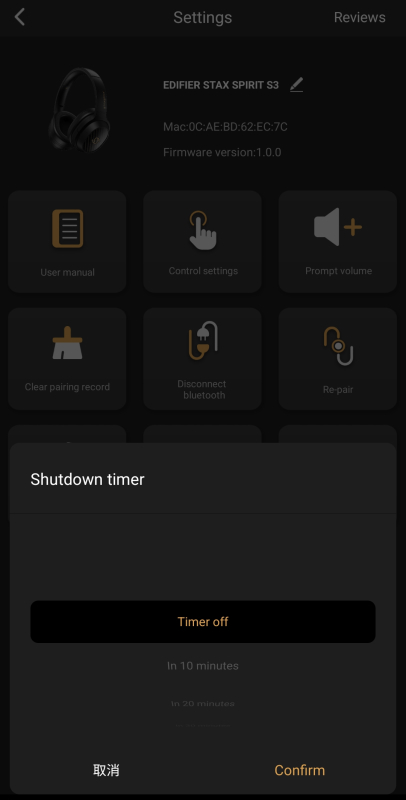
What the app mainly does: it shows the battery level, it lets you switch sound settings for different types of earpads (the headphones DSPs adjust the sound depending on their type), and it allows choosing one of three possible equalizer settings: ‘Classic’, ‘Hi-Fi’ and ‘STAX’.
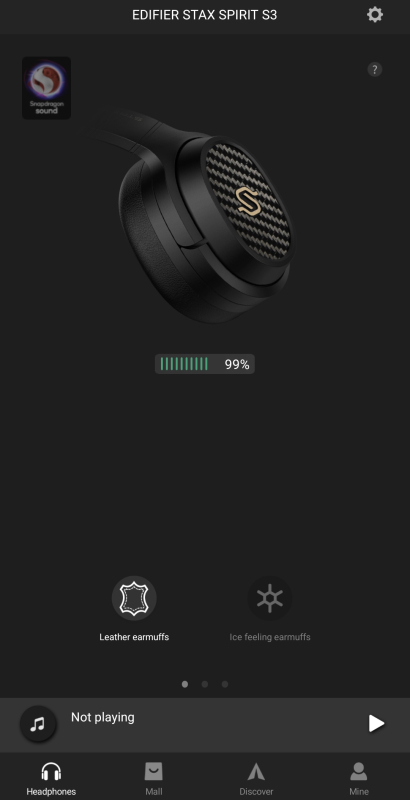
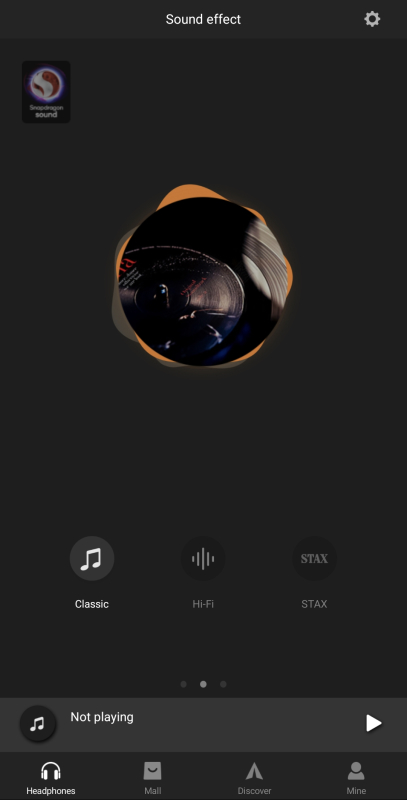
The other options are disabling headphones, showing user manual, adjusting the notification volume.
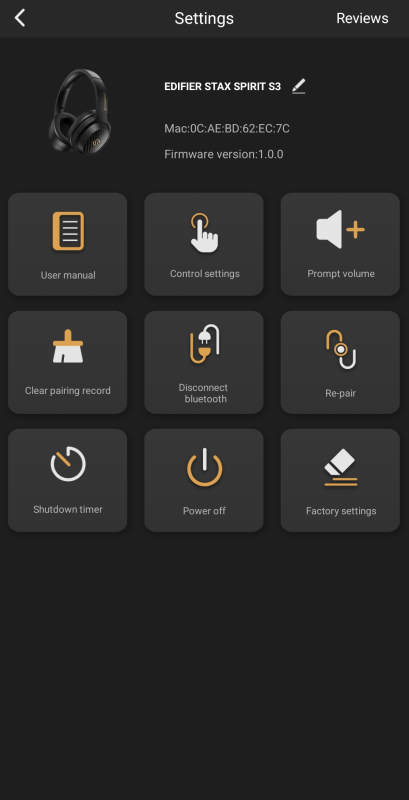
The only really useful option, which is the control setting, it… Let’s say, you won’t be amazed at how many options it has, but you’d still be able to set the reaction to double or triple pressing of the central button. Isn’t it awesome? I don’t know. Not really.
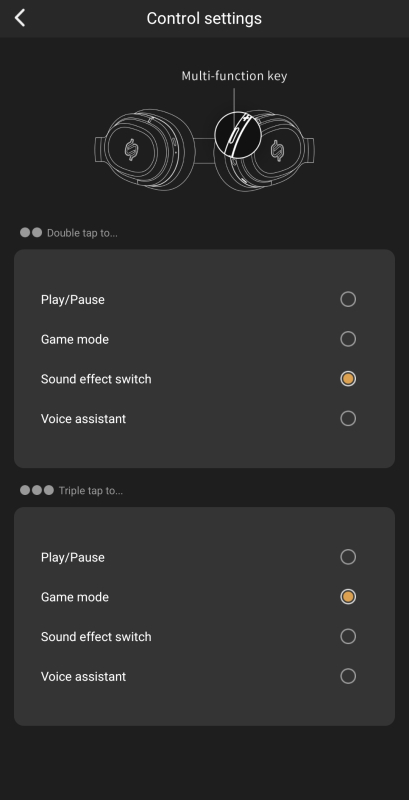
The app is crap. Crappy app (may be the name of my first album). But the cherry on the cake is that when you turn off the headphones, the ‘Headphones unconnected’ notification will remain at the notification bar until you just go and kill the app manually, you can’t swipe the notification out from your screen. That’s how serious companies handle their serious product stuff. Swipes are for kids.
Ergonomics
The kit, again, includes two pairs of different earpads:
- the leather ones;
- the fabric ones: the manufacturer calls those ‘ice feeling earmuffs’.
Both are just great, by the way. The lambskin ones are slightly denser, and fabric ones are much softer and more adjustable in terms of deformation. Both pairs deliver excellent sound isolation over the entire frequency range. Personally, I liked the fabric ones more because of the incredibly gentle feeling against your scalp, and they take the right shape literally in the first few seconds of using.
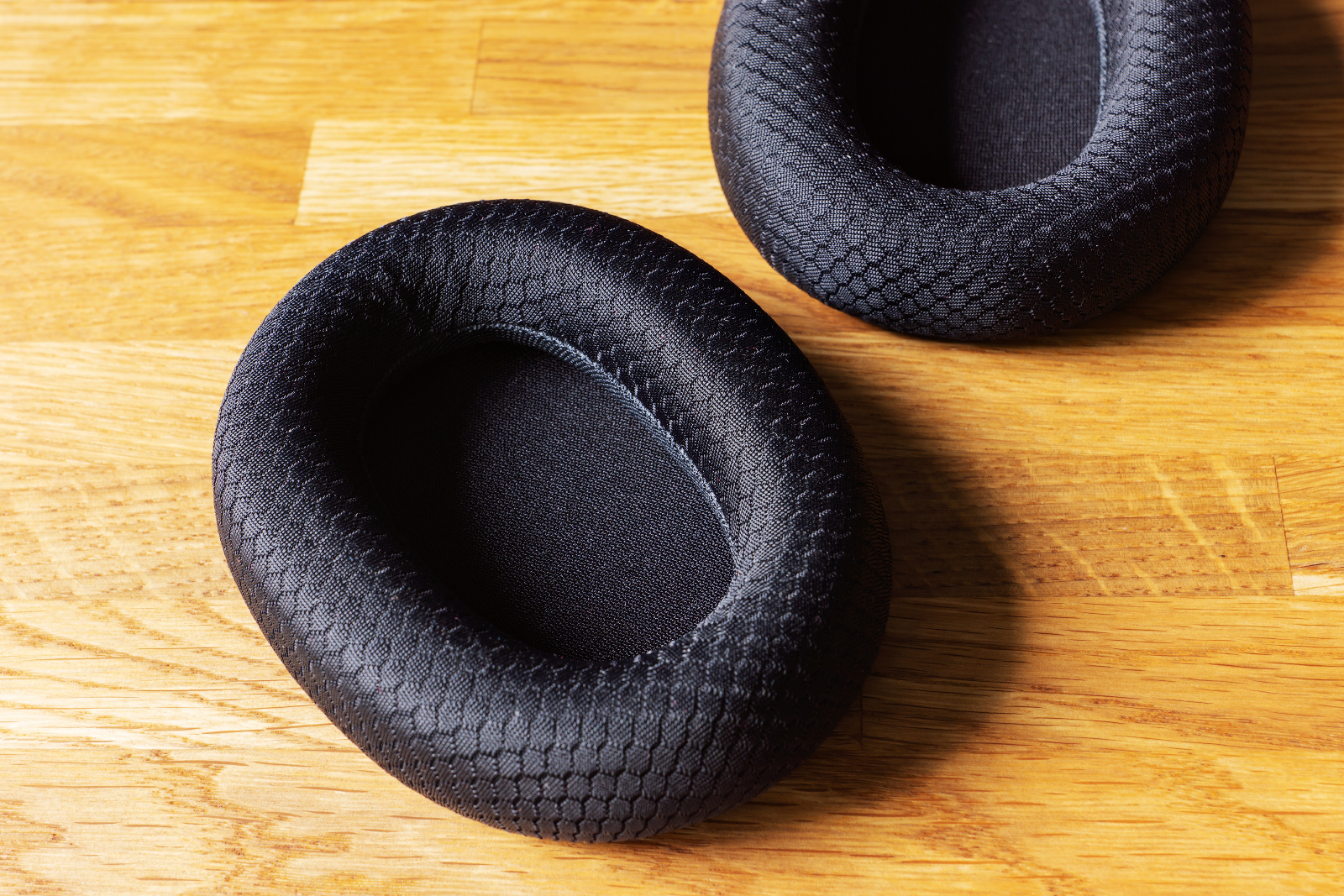
The rigidity and thickness of the headband lining are also good, the headphones sit comfortably. The precisely calculated pressure level prevents any slips or falls when you’re power walking to catch your bus, running from a stray dog or turning your head sharply (ever tried to cross a 6-lane street outside the crosswalk?). And, at the same time, the headphones don’t squeeze your head to pop it like a watermelon.
Well, let’s not forget about other nice things the S3 feature.
- The headphones can fold, which is convenient for taking them with you.
- The battery life is, try not to faint, 80 (eighty) (e-i-g-h-t-y) hours. And it sounds about right. Moreover, a 10-minute charge gets you 11 hours of listening time, and the battery is fully charged after about 2 hours.
In other words, the S3 are very-very comfortable, and it can’t be denied. BUT, as you might know, ergonomics isn’t only about a comfortable fit or a good battery time. Now it’s time to spill the bad news.
- Plastic parts. The plastic used in these headphones is a true fingerprint magnet: you touch it, and the fingerprints can only be removed with a good scrub.
- Controls. There’s no way to switch tracks in any way (actually there is: keep on reading). And the volume buttons change the sound by 6 units at once, so it often turns out that the headphones play too quietly, but after a single press on the ‘+’ it’s already too loud.
- Equalizer. Only three preset options, no custom configuration is there.
- Acoustic transparency. None, although there’s a mic. Only one mic, but still.
- Analog connection. In fact, the connection via an analog 3.5-jack cable isn’t really analog – the headphones must still be turned on. That is, the sound equalization is always applied, but only with primary analog-to-digital conversion. Nevertheless, with 80 hours of operation, the S3 can easily go as wired headphones: who cares if you wear them on your neck all day being turned on all the time, when you have this huge battery life!
Quick specifications overview
- Design: over-ear, closed-back.
- Driver type: isodynamic.
- Weight: 329 grams.
- Battery capacity: 1500 mAh.
- Impedance: 24 Ohms.
- Bluetooth version: 5.2.
- Supported audio codecs: SBC, AAC, AptX, AptX HD, Apt X Adaptive.
Subjective sound impression
I’ve been testing these headphones for about 5 hours.
I started my listening path with the leather earpads and a ‘Classic’ sound profile. First impression: the headphones emphasize the midrange frequencies, the music sounds clear and close to the listener, and it’s all quite dynamic and detailed. The S3 can be really loud, too: much louder than the average headphones of a similar design. But the rest is all disappointment: the headphones emphasize the top-frequency range more than they should. In almost any track, the percussions, the grinding, squeaking sounds and other sounds of musicians touching the strings just outvoice any other stuff. And it actually seems like not only the top section is emphasized, but also the portion after 10 kHz: there’s often a noise, which I initially took for the amplifier interference. But no, this is exactly the ‘dirt’ the S3 extract from the ultrahigh frequency range and highlights even more. At the same time, the bass and subbass don’t feature any texture and just buzz right into your brain. That’s what a wrong amplifier would do to your music, as if its power isn’t enough to control the membrane vibrations.
Here are the three key words to describe my perception of the S3 sound: mumbling, ringing, ‘dirt’. It’s a kind of W-shaped sound delivery, but incorrectly implemented in terms of both sound tuning and the electrical part design of the headphones themselves.
When switching the equalizer to ‘Hi-Fi’ and ‘STAX’ modes, the sound picture changes for the worse (a new low, guys). In the ‘Hi-Fi’ mode, the lower and upper frequencies are pushed up even more, and the ‘dirt’ gets more intense, and the bass hum even worse. The ‘STAX’ setting is a different, but still not a better option: the bottom section of the frequency range is even lower, and the top gets even higher. The midrange with sibilants and metallic ringing is there.
The fabric earpads change the situation for the better and level the bright top section a little – no radical changes, though, it just gets better. All of the above problems remain.
Trying to find an at least acceptable sound option, I played with the physical earpads, the earpad settings in the app, and the equalizer presets. What I think can be an okayish option: fabric earpads on your headphones + leather earpads in the app + the ‘Classic’ equalization. Boom! Such a combo makes the frankly bad S3 sound just bright (without ‘too’ or ‘very’), but quite decent, slipping into sibilance in just a couple of tracks I’ve listened to while testing. So you know: the poorly controlled lower frequencies are still there.
This is when I should have written about what the S3 do when connected via cable, but, sorry, I don’t quite see the point.
Frequency response measurements
The headphones were used with the Hiby R5 player (AptX HD). A measuring rig conforms to the IEC60318-4 standard. For each of the earpieces, the measurements were made until 3 to 5 reliable and stable measurements were obtained for the left and right channels; any deviant measurement results were excluded. The smoothing is indicated on the graphs. I’ve described the limitations of the rig and the headphones measurements in general in this article.
Leather earpads
Leather earpads + ‘Classic’ equalization:
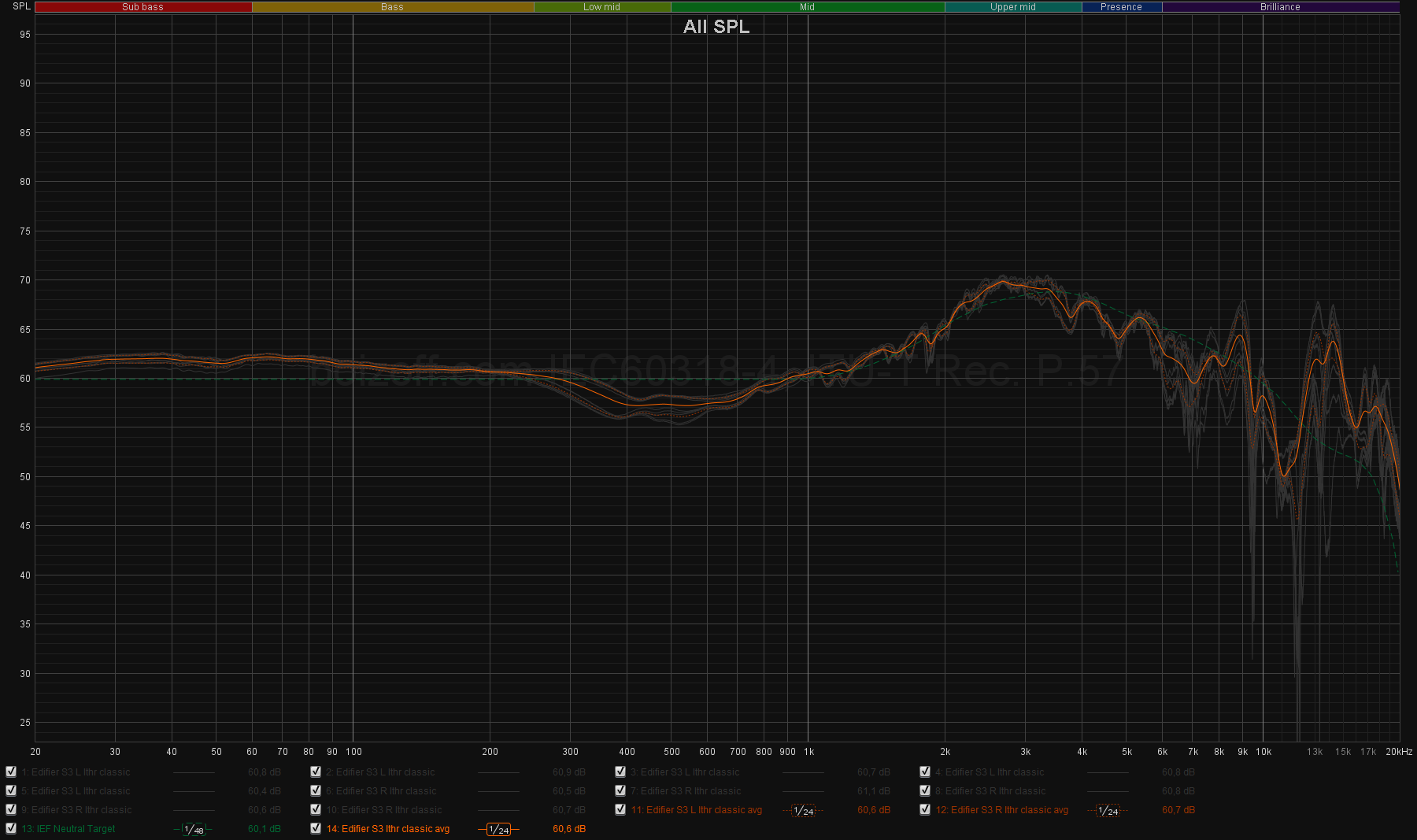
Leather earpads + ‘Hi-Fi’ equalization:
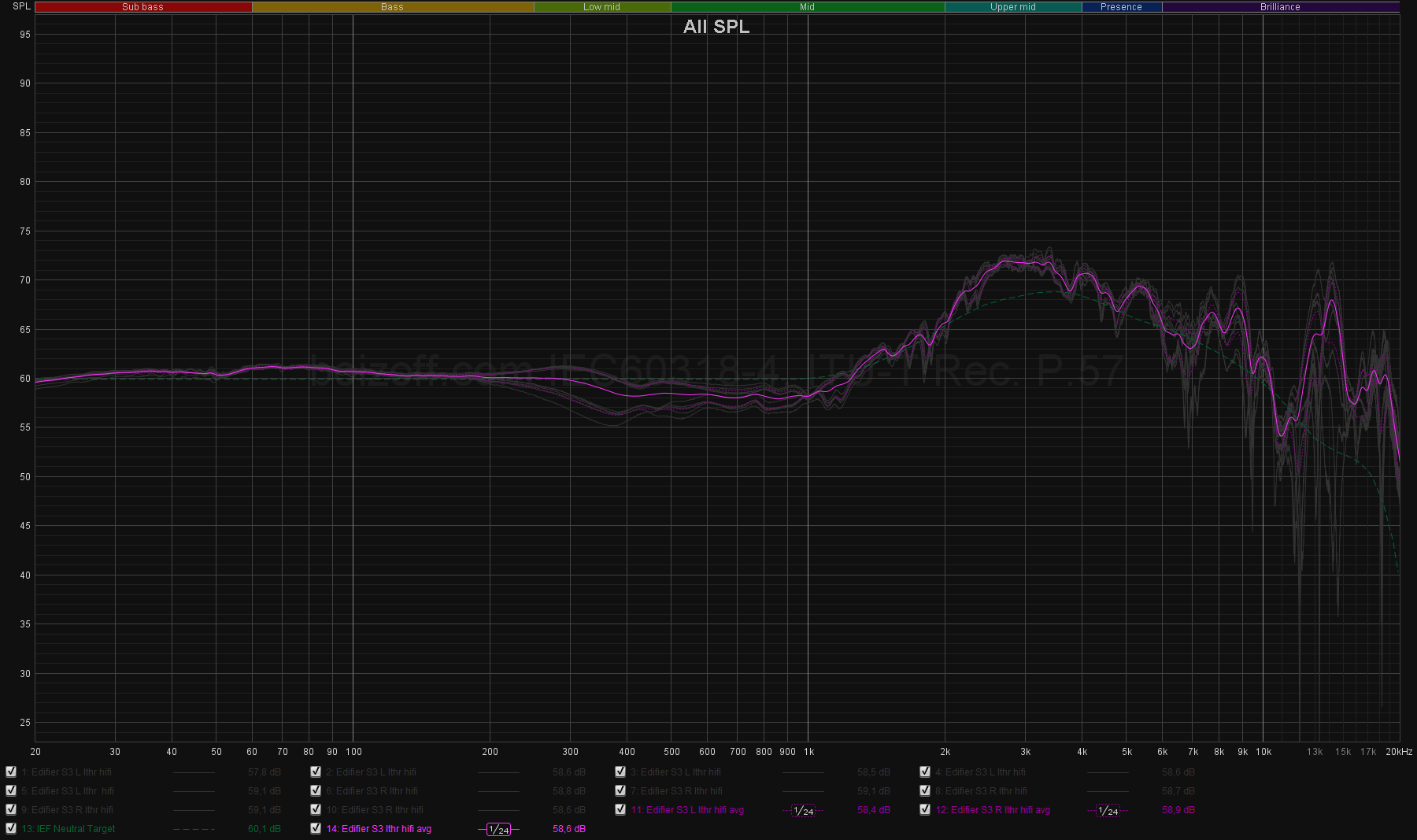
Leather earpads + ‘STAX’ equalization:
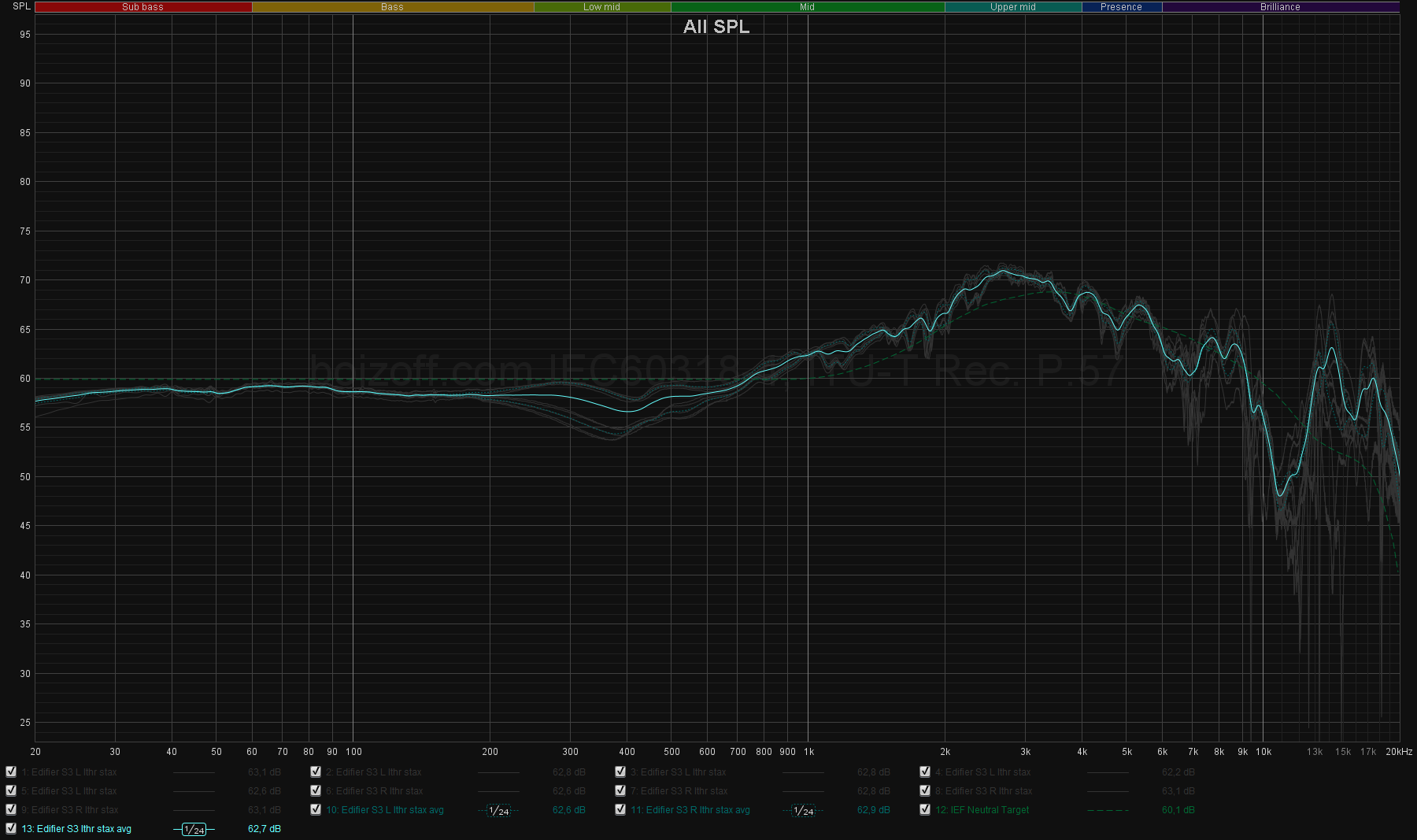
Leather earpads, equalization comparison:
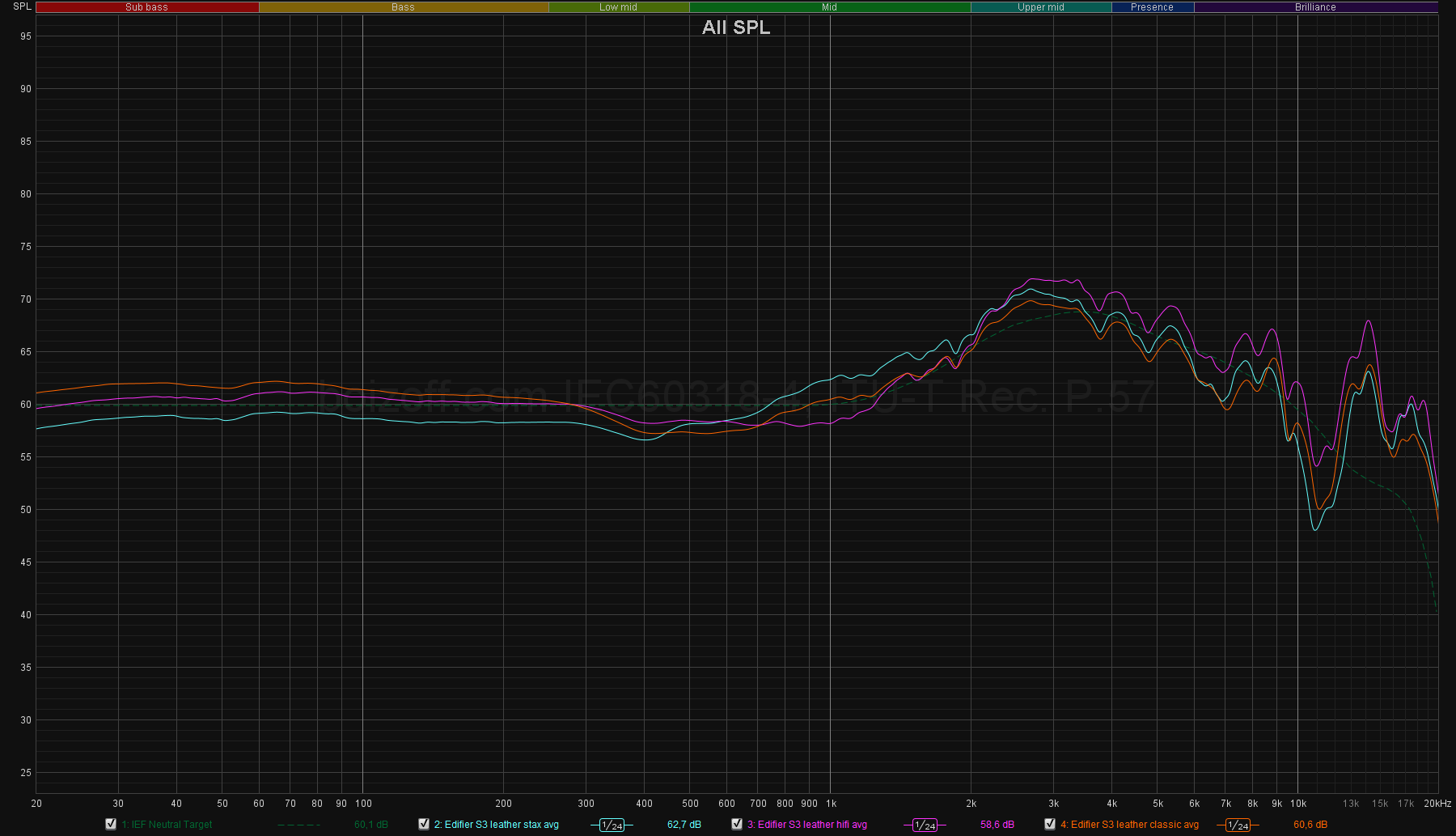
A couple of things to point out here.
- A slight and smooth decline at about 500 Hz can’t be heard by a human ear.
- At 6 kHz and above, the S3 sound is very dependent on the earpad rotation and pressure. A slight change in fit can cost you +/- 8 dB (or even more) at certain frequencies.
- A separate narrow peak at 9 kHz remains at any equalizer setting – only its size changes. At the same frequency, the left earpiece behaves differently from the right one: the volume difference is some 6 dB.
- That curb at 12–16 kHz isn’t even a measurement error and it can be heard, and this is the reason the S3 sound ‘dirty’. Not the sexy ‘dirty’ but yuck type of ‘dirty’.
- The left and right channels are poorly balanced here and there, and the discrepancy extent (surprisingly!) depends on the selected equalizer option. Theoretically, to get such a result, you’d need to adjust the equalization for the left and right headphones separately.
As for the the inarticulate mumbling bass, here it is:
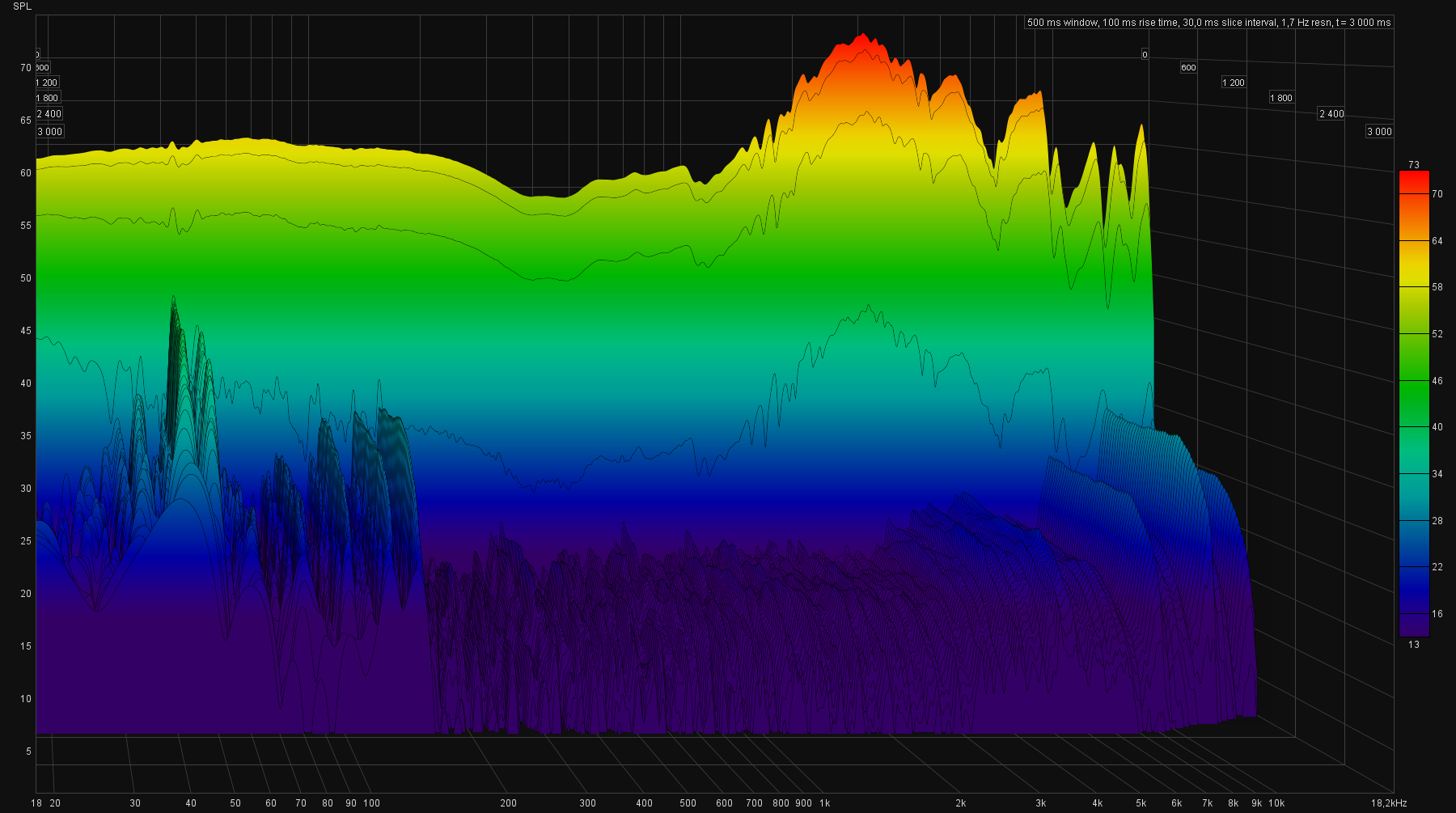
Fabric earpads
Fabric earpads + ‘Classic’ equalization:
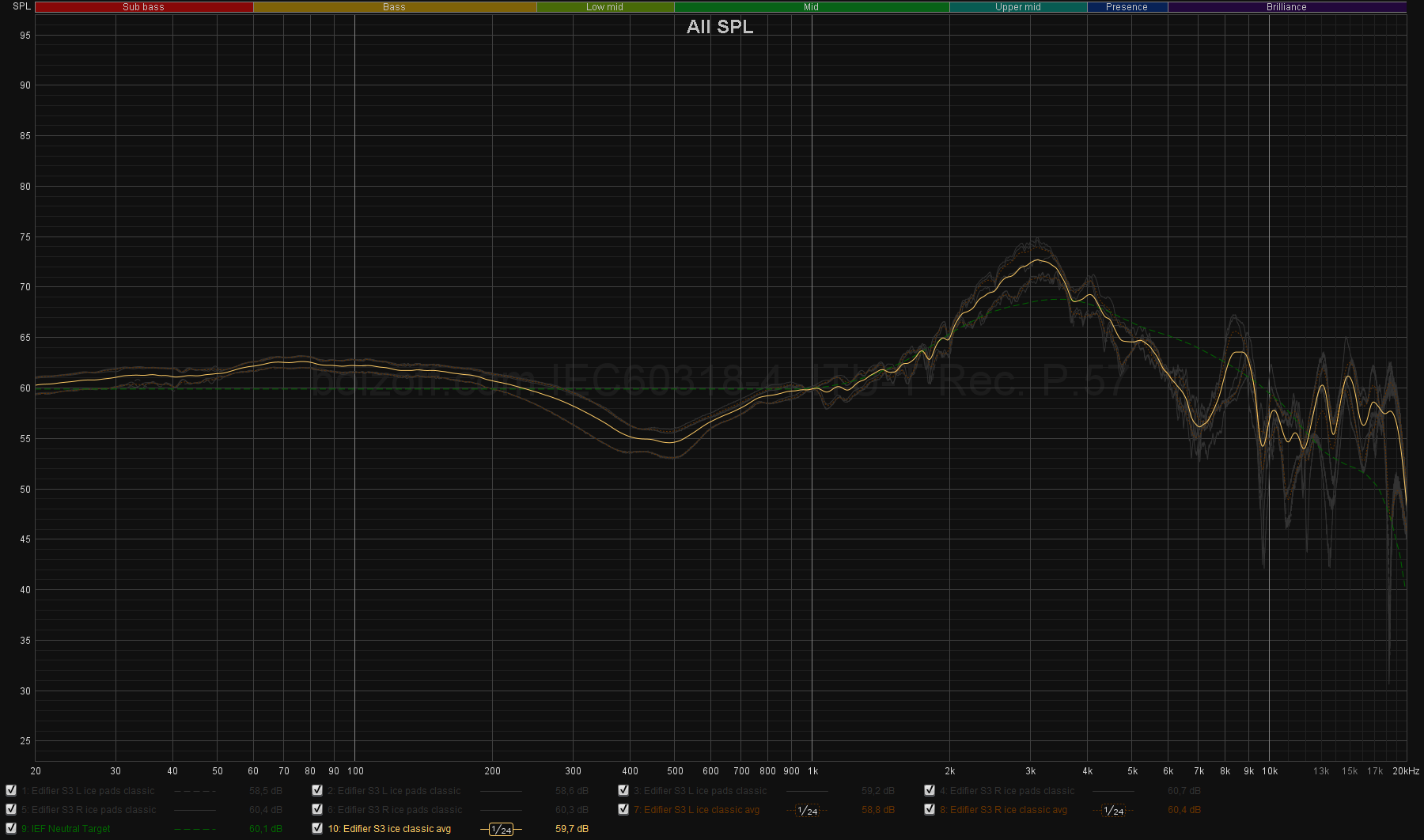
Fabric earpads + ‘Hi-Fi’ equalization:
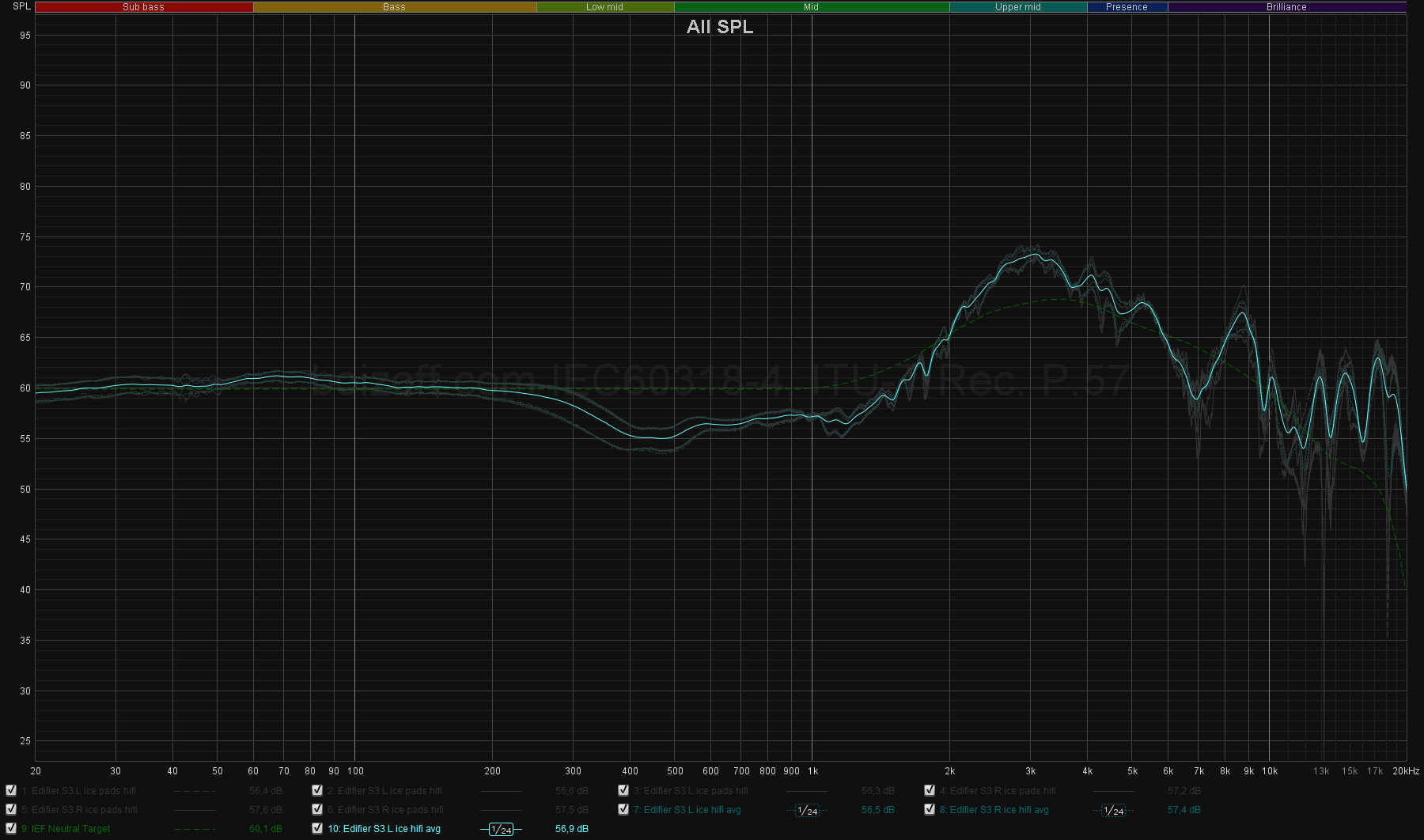
Fabric earpads + ‘STAX’ equalization:
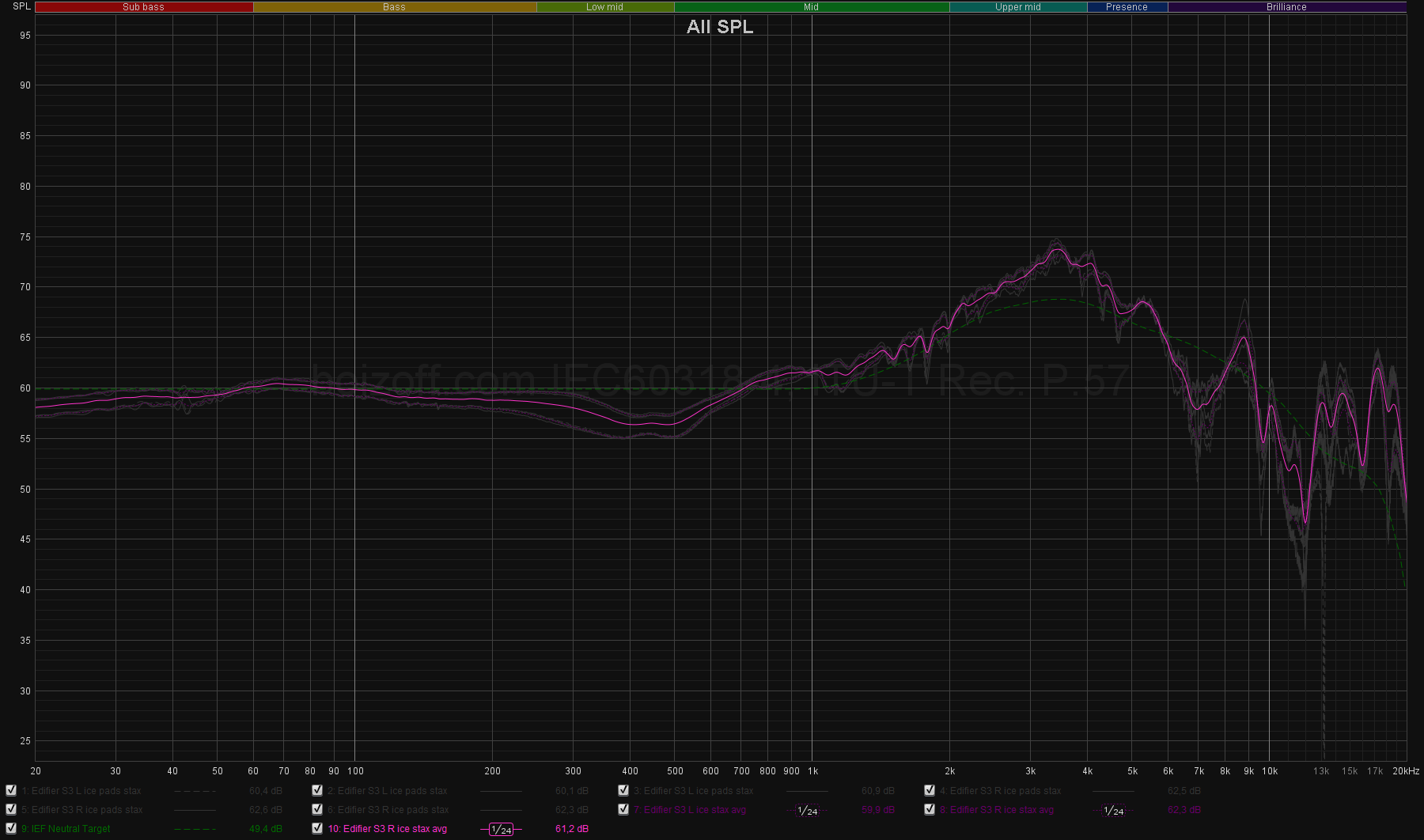
Fabric earpads, equalization comparison:

Combo modes
Leather earpads, fabric earpads selected in the app, all equalizer options:
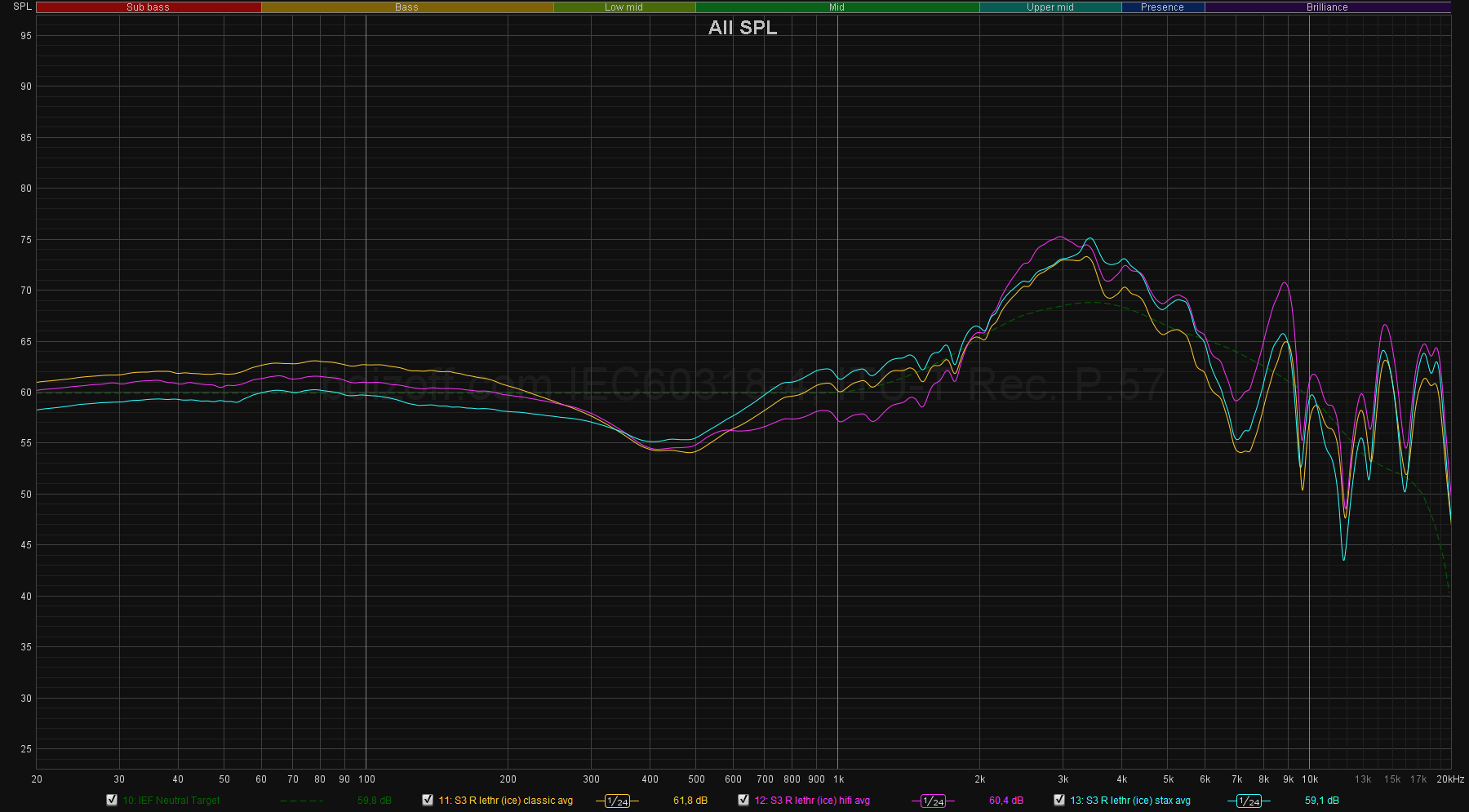
Fabric earpads, leather earpads selected in the app, all equalizer options:
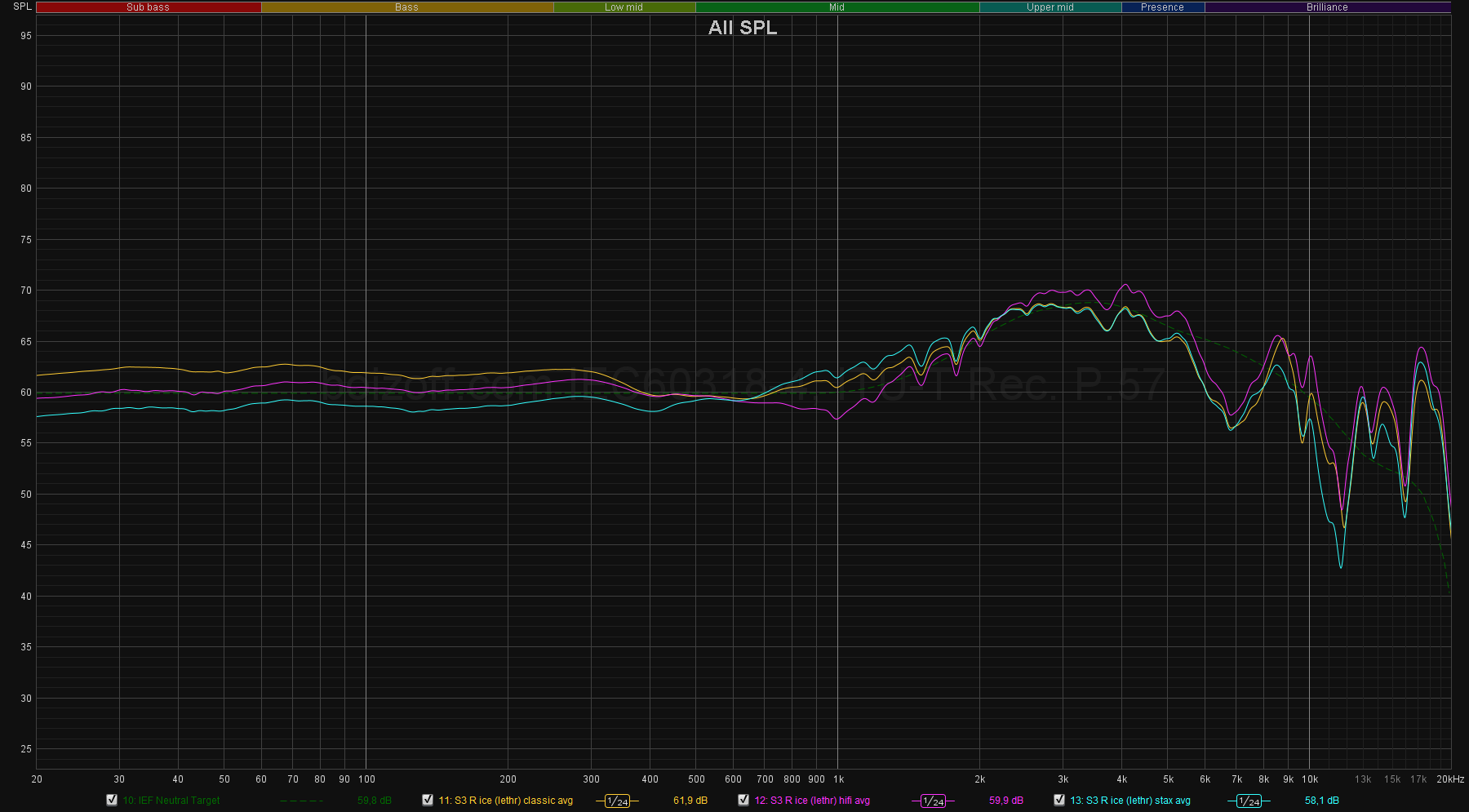
That yellow line in the last pic shows the most okay sounding option.
There’s a thing I’ll point out here: some say that when tuning the S3, the Edifier aimed at the Harman curve. They really didn’t. Look at the Harman curve, then look at the Edifier’s blunder.
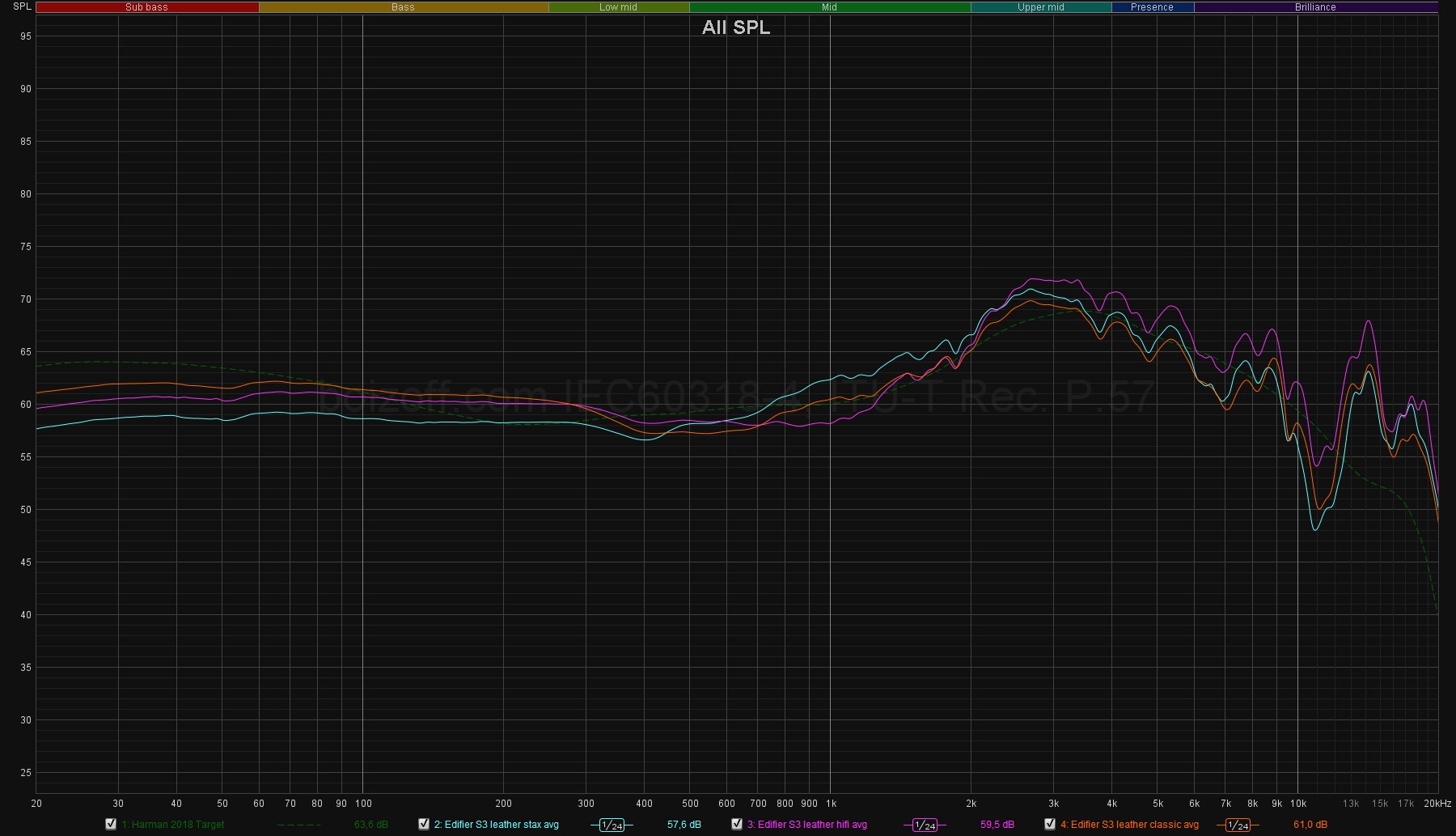
Summary
Here’s my vision of the whole S3 situation: the Edifier is trying to sell exciting technology names meaning something to many headphones fans – EqualMass, Audeze Fluxor, Uniform, Fazor and, of course, STAX (or rather, its spirit, as the model name suggests). A thoughtful buyer doesn’t exchange their money for words used in press releases and for being part of the elite group of consumers of premium technologies or, umm, spirits. Such buyers pay for the sound.
And the S3 are clearly bad when it comes to the sound.
These headphones sound more or less decently in exactly one combination of earpads + earpad option in the app + equalizer option. A combination that hasn’t even been designed by the manufacturer. And even in this case, you’ll need to painstakingly select tracks so that they aren’t saturated with a complex lower-frequency component and a pronounced higher-frequency component. Your S3 playlist should only contain some exceptionally well recorded tracks. Can you do that? Can your favorite artist do that? Of course, if you’re an avid fan of studio piano recordings, then it’s your paradise, since it’s the only type of music you can really enjoy with the S3. And it’s especially sad that the manufacturer, instead of tuning the headphones with an internal DSP, willingly chose this mumbling and ringing kind of sound delivery. It seems a pretty easy choice to consider three simple settings: the Harman curve with bass, that same curve without bass, and with a pinch of something resembling a ‘STAX house sound – not too stretched, but an even lower-frequency section and an accentuated middle part with a separate neat accent at 5 kHz. And everything would be just awesome! Fantastic! Utter success and wild sales. But the Edifier decided to go another way: an absolutely odd one. A muddy road instead of a freshly built highway.
Let’s ask some obvious questions now.
If I’m right about the insufficient power of the built-in amplifiers, maybe the Edifier shouldn’t have gone for the 80-hours battery life at the expense of sound quality? Maybe 20 hours would be enough, but the lower frequencies would be controlled better instead? Why is there an AptX HD as HiRes codec? Why not LDAC? The AptX HD only dances with devices powered by Qualcomm processors, did they know that? Was it too difficult/expensive/gross to make at least one additional button which you could configure to switch the damn tracks? And why, finally, was there enough money for an article in Forbes, but not for correct translation of some 20 dumb phrases in the mobile app interface?
To be a complete ass, I’d say that, for example, the Sony WH-1000xm4 cost some similar money. These sound nasty when right out of the box, but the equalization of their proprietary app does the magic, and the headphones sound quite decently. They also feature active noise reduction, acoustic transparency, LDAC support, wear sensors, customizable controls and lord knows what else. And – attention! – a nicely packed app.
Shame on you, Edifier.
P.S. Please note that the S3 aren’t an Audeze LCD-1 copy. The cases, the headband, and the folding mechanism are identical. But the LCD-1 are open-back ones, and the S3 are closed-back. And, look at the photo, their drivers are different (source).
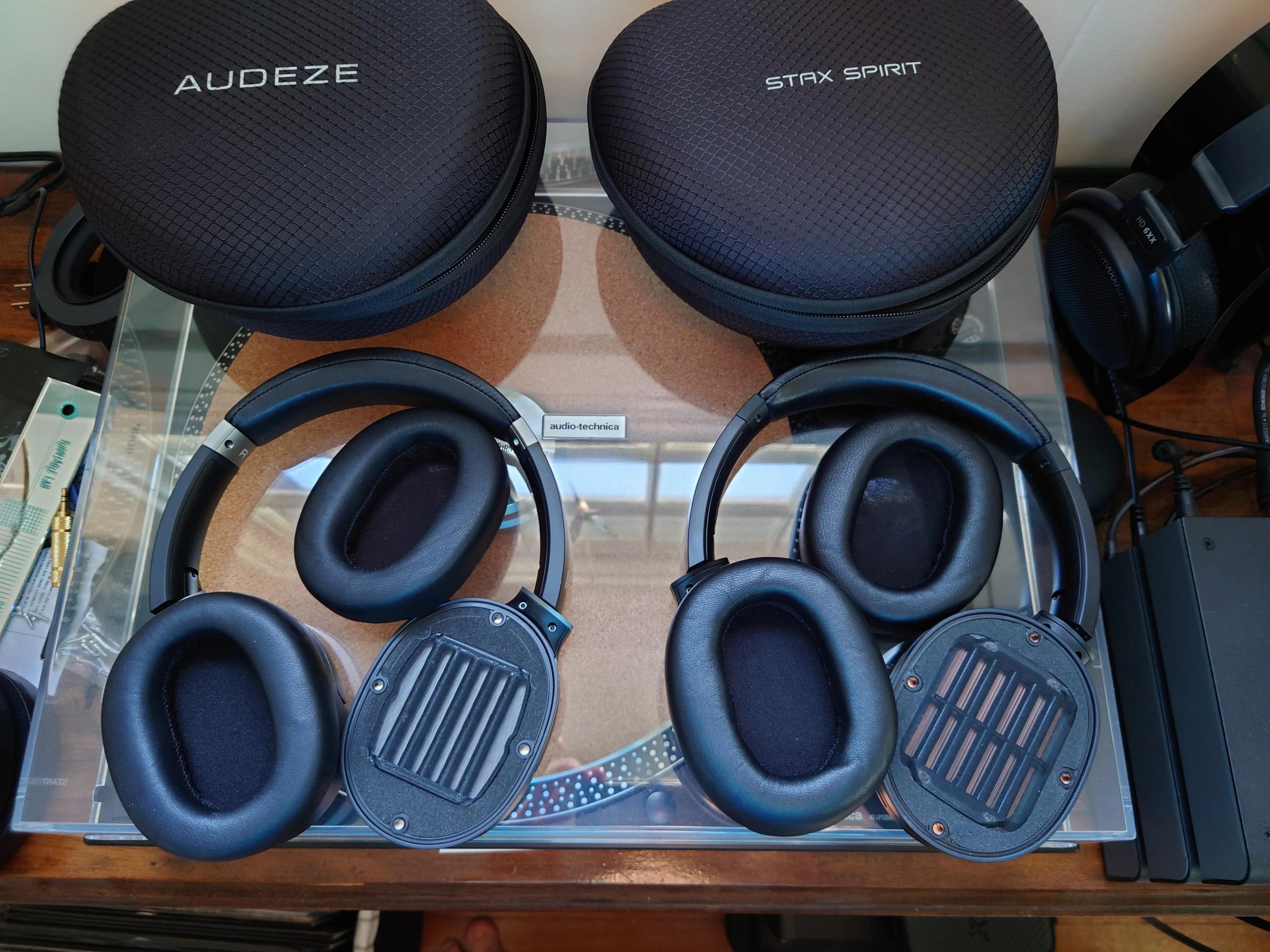
P.P.S. You actually can control the playback, it’s just not obvious:
